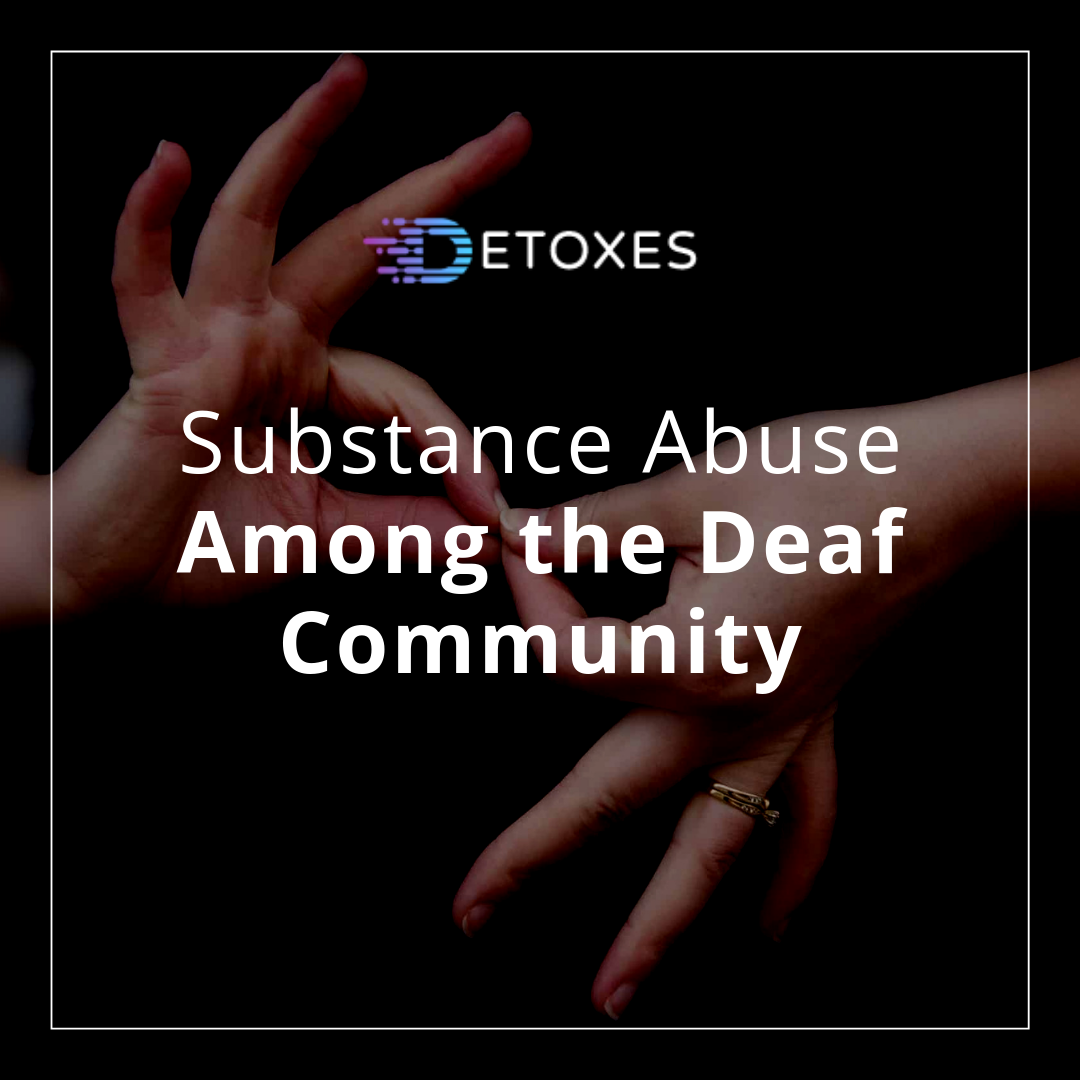Substance Abuse Among the Deaf Community
Substance Abuse Among the Deaf Community
People of any type of disability are more likely than the general population to suffer substance abuse problems. This is equally true for people who are Deaf and hard of hearing. This issue is made much worse because the Deaf often have a hard time finding adequate addiction treatment. We will look at some of the indicators for substance abuse among hard of hearing individuals; some of the substances and the effects of those substances; and possible solutions for better treatment for an at-risk population. This is a community guide about substance abuse in the Deaf community.
Causes of Substance Abuse Among the Deaf and Hard of Hearing
The connection between struggles, life difficulties, negative emotions, and outsider status and heavy use of drugs and alcohol are all clear and well-known. One of the populations that often feels the need to turn to alcohol or other drugs is people with physical or mental disabilities.
Those with disabilities are more likely than those without to have a substance use disorder (SUD); a study published in the Journal of Drug Education took a comprehensive look at high school students with hearing loss, tracking their substance use at one point in time and following up years later. It found that 59% of students drank during the first period and 42% during the second; 21% used another drug at point one, and 18% at point two.3 This means that more than half of young Deaf or hard of hearing citizens drank and one in five used drugs, with the majority of users continuing their habits into adulthood.
But what causes this prevalence of use of substance abuse in Deaf communities? One important thing to remember is that folks in this population have some of the same risk factors for substance use as members of the general population who are more likely to abuse substances.
These include:
1) A history of abuse in the family.
2) Depression or similar psychological disturbances13.
3) Societal messages that it’s understandable (or even expected) to use drugs to cope with these issues13.
People with these stressors are more likely to drink or use drugs, and we will explore the prevalence of these issues among those who are Deaf or hard of hearing.
First, though, let’s look at some of the factors unique to hard of hearing people (some of which are also true of anyone with a disability).
- Isolation
We think of hard of hearing community as frequently using sign language with an interpreter or family members and friends. More recently, hard of hearing individuals can make use of tablets or phone apps that they can type into.
This may make people simply think that the Deaf and hard of hearing integrate into society seamlessly, and have no problem communicating. (Note: Deaf with a capital “D” is used to describe and identify a group of people or the Deaf community; Deaf with a lower-case “d” is used to denote a disability that takes away one’s hearing ability; while hard of hearing refers to people with a variety of partial hearing disabilities9).
What we often fail to think about, though, is that the Deaf are limited as to how many friends and family members know sign language and that the use of devices is onerous and limiting on interactions. Ninety percent of children born Deaf are born to parents with no prior experience with sign language1. Sign language is far from universal in homes with Deaf children; sometimes, lip reading is a substitute, and some other methods are used.
As of 2012, 80% of born Deaf children “in the developed world” are given cochlear implants, which allow some degree of hearing. These children learn speech in a limited fashion, and this may be a substitute for some sign language. In fact, one school of thought discourages the teaching of ASL based on the philosophy that cochlear implants will bring the child into the mainstream world5. This often results in limited or stilted language use.
People have a hard time understanding the scope and character of the isolation that the Deaf confront due to their unconventional language use. American Sign Language is very misunderstood by the general public, with many people presuming that it’s as simple as having a sign equivalent for each English word.
However, ASL is actually a self-contained language, separate from standard written or spoken English. It contains its own rules for word order and grammar10. For example, when a Deaf person is signing and asks a question, he or she leans forward and raises eyebrows10. This could indicate impatience or some degree of upset to a hearing person who is communicating with the Deaf person through an interpreter.
Yet, members of the Deaf community face even bigger problems. Another serious issue centers around language acquisition in general. Remember that Deaf students are expected to read in class, and it is assumed that they will digest and interpret the information roughly the same way other students would, as they also would with signed material.
But let’s take a closer look. Because the 80% of Deaf children who receive cochlear implants can hear to a degree, they are taught spoken language, which will then lead to reading as is the case with all children. However, what about the very early years, before the implants?
Humphries et al. assert that “because of brain plasticity changes during early childhood, children who have not acquired a first language in the early years might never be completely fluent in any language.” Thus, the researchers, continue, “subsequent development of the cognitive activities that rely on a solid first language might be underdeveloped, such as literacy, memory organization, an number manipulation10.”
This can mean having problems in school, and not necessarily having a good grasp on language. When you add to that the differences between ASL and standard English, you have a person who is caught between worlds, and perhaps isolated from all of them. Some people with speech abilities do not embrace the Deaf community and go to mainstream schools. There, they can face negative viewpoints due to the issues and struggles just explained. A respondent in one study told researchers, “there seems to be a correlation, with the general population, that if your hearing goes down, that your IQ does too11.”
All of this is compounded by the tragedy that Deaf people often struggle to develop social skills and recognize what is or is not socially acceptable4. This can cause substance abuse among the Deaf or hard of hearing.
- Low self-esteem
A comprehensive 2014 study published in the journal PLOS One found that Deaf children had lower self-esteem than their non-Deaf counterparts. This was particularly true of those who attend schools for the Deaf12.
Isolation by itself may or may not lead to substance abuse in the Deaf community since isolated people could be perfectly content or busy on some sort of project. However, a combination of isolation and low self-esteem creates a terrible combination. One cannot turn to friends or find common ways of building self-esteem and will not only turn to substances as a result but are also left to these substances due to their communication deficit.
- Depression
A review of the literature, published in the Annals of General Psychiatry, found that Deaf adults had a higher rate of depression than the general population14. One has to appreciate the difference in dealing with depression for a person who does not have access to the entire world of language and a large number of possible conversation partners. One sees the causation with substance abuse in the Deaf community.
- Abuse
As mentioned above, among all populations, individuals who have been the victims of any kind of abuse are much more likely to develop substance use disorders. A study by Anderson et al. refers to multiple studies that report Deaf people report levels of abuse that are twice as high as the hearing population1. The abuse includes intimate partner violence, sexual assault, and crime victimization.
Another report showed that a shocking 54% of boys and 50% who were either Deaf or hard of hearing are victims of sexual abuse7.
Anderson et al. explain that Deaf people are vulnerable to these kinds of mistreatment due to “deprivation of early language development, conflict in the family over education and communication methods, poor/inappropriate parental involvement, low self-esteem, and social isolation.1.”
4a. Difficulty dealing with trauma
Another factor with a big and hard-to-break causal chain is that Deaf people have a much more difficult time dealing with trauma than the hearing population. This, of course, compounds an already unacceptable and deeply sad situation.
First, we need to understand very clearly that people without their sense of hearing experience trauma differently from others. Anderson et al. give us a heartbreaking and very vivid illustration of this idea. One woman they talked to in their study relates:
“My parents dropped me off at a Deaf residential
school when I was 3 years old. They didn’t sign;
I didn’t speak. We had no shared communication,
so I had no idea where I was.
When they left, I was inconsolable. I was terrified
I would never see them again.”
She concludes the upsetting incident by saying, “[f]or most of my life, I continued to blame my mother for this experience15.” It is unclear what motivated the parents to cause their daughter the unspeakable horror of feeling she’d never see them again. However, one may guess they felt they were doing the “right” thing by taking her to a school for the Deaf where, in their minds, she’d be given the best of care.
Yet, they somehow failed to understand that because they were among the aforementioned percentage of parents who don’t sign with their Deaf child, the fact that they knew where she was going and that they’d see her soon, she had no way of understanding this.
This demonstrates the isolation Deaf people are in, and how their different way of comprehending their environment can cause them trauma, and subsequent substance abuse.
As to how Deaf citizens grapple with trauma, the interviews about trauma conducted by Anderson et al. demonstrates that it often manifests itself in symptoms associated with PTSD (post-traumatic stress disorder). Interviewees frequently reported “intense fear, helplessness, or horror” from the traumas they experienced—these were previously qualifications for PTSD.
Anderson1 explains that the subjects of the study perceived great emotional harm from traumas earlier in their lives, and those symptoms of PTSD can be present even when the traumas experienced don’t meet the definition of Criteria A—the most severe—traumas.
It may be that one reason Deaf persons are particularly vulnerable and sensitive regarding trauma is that they are, as outlined above, isolated from so much of society, and may have great difficulty communicating their feelings to someone who can, in turn, show comprehension of them.
- Discrimination
In addition to suffering abuse in the home and having acute psychological traumas. As a result, Deaf people also undergo discrimination in schools and the workplace and other institutions. Discrimination means being blocked from opportunities available to other people, or otherwise being treated in a way that does not carefully weigh your merits, abilities, and potential.
Before we go into greater detail on discrimination in terms of employment, we should discuss a phenomenon called audism. This refers to the belief among the hearing population that they have or should have greater rights than the Deaf and that the Deaf are insufficient or inferior.
Deaf expert Jamie Burke says that, among other things, audism takes the form of:
- Demanding that the hard of hearing and Deaf conform to mainstream culture.
- Lowering expectations for the performance of the Deaf due to their Deafness
- Refusing to sign, to arrange for an interpreter, or accommodate a Deaf or hard of hearing2
This is important to understand because what drives some of the discrimination is audism. In 2019, National Public Radio did a lengthy feature on workplace discrimination. One of the people they profiled for the story is Amanda Koller, who is finishing her second master’s degree, and who applied for 1,100 jobs in 2018 without getting any full-time, permanent job.
Many of the professional jobs for which Koller has applied require a phone interview. Koller would request an in-person interview so that she could lipread. Hiring committees either told her they wouldn’t accommodate her or simply didn’t contact her further8.
When Koller began to use a phone that printed out transcripts of what the other party was saying she found that people would “get so angry and say, I don’t have time for this and hang up on” her.
The ADA (Americans with Disabilities Act) went into effect in 1992; according to NPR’s report, CEO of the National Association of the Deaf, Howard Rosenblum, says it’s “unclear whether the ADA has had a significant impact on Deaf employment rates8.”
It should be noted that many companies are sued for not giving proper accommodations to the Deaf. Whether it is not offering a job or discriminating against an employee, it can be very hard to win a discrimination suit against a company.
A person who has suffered ridicule, exclusion, depression, and discrimination, will have a psychology that may lead to substance abuse. This is why substance abuse in the Deaf community can be a more difficult problem.
Late Deafness
While many Deaf people are born with their loss of hearing, there are also those who lose hearing due to illnesses, injuries, brain damage, etc. These folks can speak fluently, but can no longer hear—they have to explain to people that they are indeed Deaf, and people don’t believe them because they speak fluently.
The isolation and depression that these people undergo can be a bit different from that experienced by other Deaf people. A late-Deaf person experiences an alarming loss and begins to feel that they now belong to a “handicapped” class when before he/she did not.
In a graduate thesis by Stormy Iverson, the participants who provided thorough narratives of their experience with late-Deafness almost all described a deep depression in the years following their hearing loss, and a feeling of being an outcast6.
That feeling only escalated as the respondents became more accustomed to life without hearing, which put them between worlds. Having grown up in the hearing world, many late-Deaf adults find it hard to assimilate into a Deaf community.
One man named Jay became Deaf in his early adult life. Jay reports that a lot of Deaf people he met had a hard time relating to him because of his sense of humor, “because it is very English, it’s very dry and I’ve never done a good job at adapting my humor to make it match Deaf culture6”
Jay says that he turned to reading since it was a solitary activity. He relates that while this gave him comfort, he “wasn’t making any interpersonal connections,” adding, “I was playing it safe by being alone6.”
It’s easy to sympathize with wanting to be “safe” while coping with the loss of a major sense. But while a late-Deaf person might still feel more comfortable about hearing culture, he or she always has to deal with the awkward and frustrating experience of helping people communicate with him or her, while being confronted with constant misconceptions about himself or herself. This can lead to substance abuse in the Deaf community.
So, it is easy to see how these varied and severe elements of alienation would lead a person to turn to substances for comfort, which could lead to the person subsequently falling prey to abuse of them. Further, if a person is between communities, one might find it hard to find help for substance abuse. As we will now explore, those with hearing loss have unique needs for substance abuse recovery.
Difficulty in Receiving Help
Now that we’ve looked at some of the factors that contribute to substance abuse in the Deaf community, it’s important to raise awareness of factors that impede folks in this population from seeking and finding rehabilitation services for their substance abuse issues.
- Lack of Interpreter
Professionals at rehabilitation centers are licensed to work with people addicted to drugs or alcohol. Having received this specialized training in addition to any general nursing or psychology education means a dedication of time, effort, and money.
Most substance abuse specialists haven’t taken the additional step of learning ALS, American sign language. Now, if a Deaf person has a personal interpreter, he or she may choose to have that person participate in a recovery program. However, a person may wish to keep addiction secret from this professional just as people from all walks of life often keep substance abuse from friends and family; further, the presence of an interpreter may compromise the candor with which a non-hearing person may interact with rehab staff.
- Group Therapy
The above issues are magnified when one considers group therapy, a key component of many rehabilitation programs. The presence of an additional professional—an interpreter—is an added wrinkle that those without a hearing disability don’t have to consider.
- Finances
Because of the particular—often restricted—employment circumstances of the hard of hearing, these individuals may have a hard time affording treatment. People who are covered by Medicaid or Medicare are eligible for rehabilitation services.
One thing to remember is that while there are facilities that either specialize in care for the disabled or who have full-time interpreters on staff, these may or may not be in one’s geographical area. This shows a need for further awareness and for more numerous facilities for people who are hard of hearing. Furthermore, Deaf education institutions need to do a better job of educating students about the dangers of substance abuse and the options available to them.
One resource to consider is SAMHSA, the Substance Abuse and Mental Health Services Administration, which helps people locate treatment that is available.
Further the Rochester Institute of Technology has an excellent national directory of services, which includes hundreds of programs, services, and facilities across the country for the Deaf. These programs offer some of the following: staff trained in ASL, 12-step programs accessible to the Deaf, and interpreters.
Conclusion about Substance Abuse in the Deaf Community
Those whose children or family members or close friends of hard of hearing persons should be on the lookout for signs of drug and/or alcohol abuse. These include the person seeming unhappy or disillusioned when not under the influence; anger or defensiveness when you suggest they have a problem; frequent use of substances outside of social settings.
A person with any disability should be treated like anyone else. We shouldn’t suggest that it only makes sense for them to abuse substances because of what they are supposedly missing out on in life. This is disrespectful to them. Instead, their substance use should be taken seriously, with no excuses or exceptions, and they should get the help they need.
References
- Anderson, et al. (2016). A pilot study of Deaf trauma survivors’ experiences: early traumas unique to being Deaf in a hearing world. Journal of Child Adolescent Trauma. 9:353-58 (2016). DOI 10.1007. Retrieved 30 March 2019.
- Berke, Jamie (2018). An audist attitude can be compared to other forms of discrimination. Verywellhealth. Jun 18, 2018. Retrieved 30 March 2019.
- Berman, BA, et al (2010) Alcohol and other substance use among Deaf and hard of hearing youth. Journal Of Drug Education. 40 (2) 99-124. Retrieved 30 March 2019.
- Brice, P. and Strauss, G. (2016). Deaf adolescents in a hearing world: a review of factors affecting psychosocial adaptation. Adolescent Health, Medicine, and Therapeutics. 2016. 7. Retrieved 30 March 2019.
- Humphries, T. et al (2012). Language acquisition for Deaf children. Reducing the harms of zero tolerance to the use of alternative approaches. Harm Reduction Journal. Retrieved 30 March 2019.
- Iverson, Stormy (2016). Biographies of hearing loss: understanding the social world of late Deafened adults Through life experience. eScholarship: UC Open Access Publications. Retrieved 30 March 2019.
- Johnson, H. Child abuse and neglect in Deaf and hard of hearing children. Retrieved from Deaf education website http://www.Deafed.net/Forms/EHDIWebinarChildAbuseandNeglectofDeafandHardofHearingChildren.pdf. Retrieved 30 March 2019.
- Morris, Amanda (2019). Deaf and unemployed: 1,000+ applications but still no job. Jan 12, 2019. Retrieved 30 March 2019.
- National Association of the Deaf. (2019). Community and Culture- Frequently Asked Questions. Retrieved 30 March 2019.
- National Institute on Deafness and Other Communication Disorders and Other Communication Disorders (NIDCD). (2019). American Sign Language. U.S. Department of Health & Human Services. Retrieved 30 March 2019.
- Terry, D.R., Le, Q. Nguyen, H.B. (2016). Misconceptions of the Deaf: giving voice to the voiceless. Health, Culture and Society. 2016 9-10. Doi. 10.5195. Retrieved 30 March 2019.
- Theunissen, S, et al (2014). Self-Esteem in hard of hearing children: the influence of communication, Education, and audiological characteristics. PLOS One. 2014; 9 (4). Retrieved 30 March 2019.
- Alcohol.org. (2019) 8 Jan. 2019. Treating alcoholics in the Deaf community Retrieved 30 March 2019.
- Turner, et al (2007). Suicide in Deaf populations: a literature review. Annals of General Psychiatry. 2007 6 (26). Retrieved 30 March 2019.
- Weaver, K and Starner, T (2011). We need to communicate! Helping hearing parents of Deaf children learn American Sign Language. Eric.gov. Retrieved 30 March 2019.








